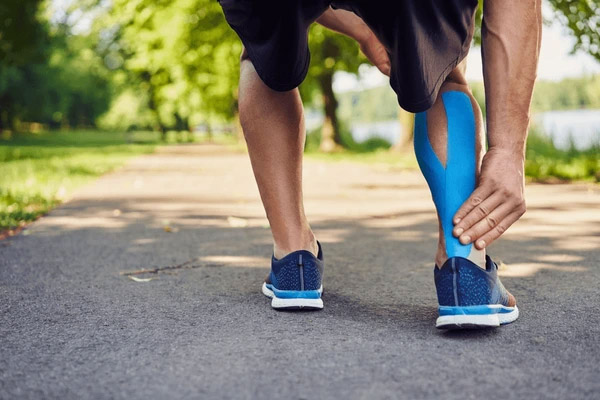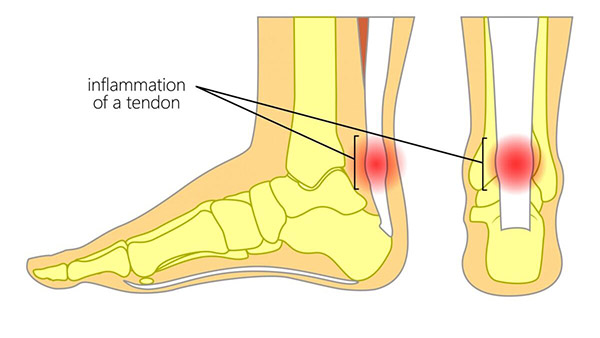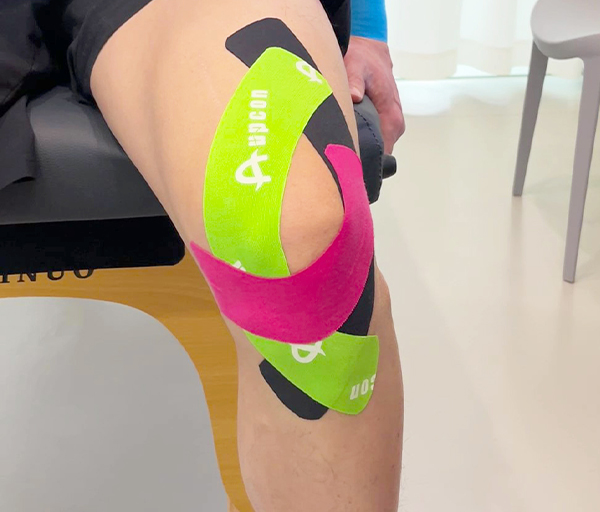For those who have suffered from Achilles tendinitis for many years, a common question is: “How can I use kinesiology tape for Achilles tendonitis to treat Achilles tendon injuries to relieve pain and improve function?” Tape for Achilles pain is an effective treatment method, and generally, we only need to learn how to relieve our Achilles tendinitis with professional physical therapists. This text will explain how to use tape and effectively reduce symptoms.

Causes Of The Achilles Tendonitis
Achilles tendonitis is an injury caused by overuse of the Achilles tendon; the Achilles tendon is a bundle of tissue that connects the calf muscle and the heel bone at the back of the lower leg. Achilles tendinitis is common in athletes who suddenly increase running intensity or overuse their legs. Middle-aged people who only exercise on weekends (such as playing tennis or basketball) are also prone to Achilles tendinitis. Patients often seek professional use of kinesiology tape for Achilles tendonitis to fix their Achilles tendons because they hope to relieve the pain caused by the injury and get better faster.

Benefits Of Kinesiology Tape For Achilles Tendonitis
Achilles tendinitis is often a problem for sports enthusiasts, and the impact is often significant. However, using Achilles’ kinesiology tape is an effective option to help recover faster and more successfully. Here are some benefits of taping for Achilles tendinitis.
Treating Injuries
Kinesiology tape for Achilles tendonitis is one of the most effective ways to treat Achilles tendinitis because you can do it yourself without going to a hospital or physical therapy center. Tape for Achilles pain can reduce pain and inflammation by applying it to the heel.
Supporting Weak Areas
For people with Achilles tendinitis, the tendons are usually fragile and cannot withstand re-injury. Kinesiology tape for Achilles Tendonitis can support the muscles and surrounding joints of the Achilles tendon, significantly reducing injuries during travel or rehabilitation training.
Retraining Muscles
Using Achilles kinesiology tape can help retrain damaged muscles and make the blood and lymph circulation of the corresponding tissues smoother; the exudate of the injured area is easily absorbed, the fluid retention between the tissues is reduced, the local pressure is reduced, and the damaged tissue is quickly rebuilt.
Improving Performance
Many athletes use kinesiology tape for Achilles Tendonitis because it helps them improve their performance and protects them from injury. If you have previously suffered from Achilles tendinitis or want to prevent it, using tape when doing intense training can be helpful.

How Should I Tape My Achilles Tendon?
First, you should choose three kinesiology tapes for Achilles tendonitis that are suitable for your calf length. You can refer to the appearance in the video and trim the round edges so they fit and do not curl up.
1. The patient should lie on the bed, stretch out the injured calf, and wipe off the excess moisture on the Achilles tendon and calf to keep them clean.
2. Take five centimeters of the first Achilles kinesiology tape and fix it on the heel without stretching. Please continue to take five centimeters of tape to wrap the Achilles tendon without stretching it. Then, pull the tape for Achilles pain with 75% tension and stick it to the middle of the calf muscle.
3. The second strip of kinesiology tape for Achilles tendinitis was applied to the heel as an anchor point and stretched 75 percent to wrap around the right calf muscle.
4. The third kinesiology tape for Achilles Tendonitis is anchored above the fixing point of the previous tape, and it is stretched 75% to wrap the left calf muscle.
5. Rub it several times and complete the pasting.
Summary
Kinesiology tape for Achilles Tendonitis is currently the most popular physical therapy method for Achilles tendinitis. It is also very effective for tendinopathy, heel pain(Heel pain relief tutorial), tendinitis, and more. It can help you protect or treat your pain before and after exercise. If you would like to learn more, please visit AUPCON.



